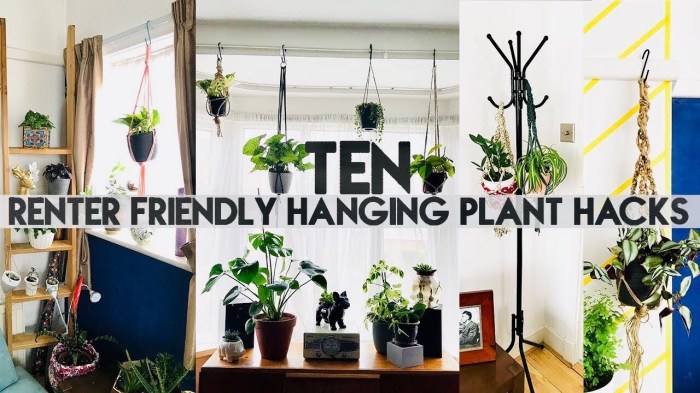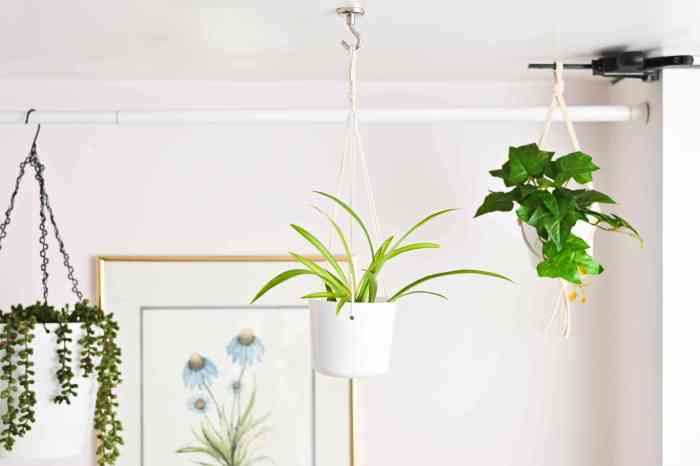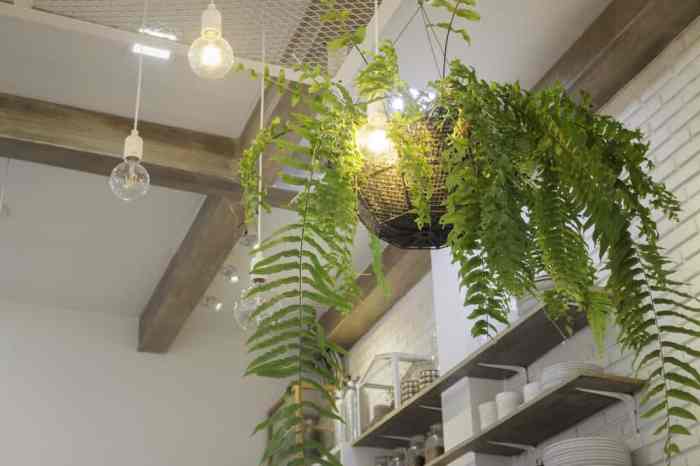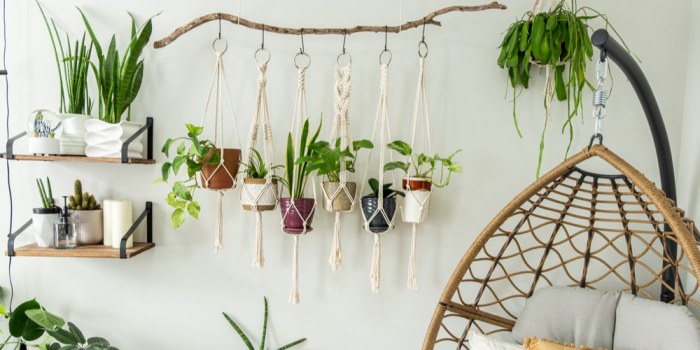Hanging plants without soil is an innovative and aesthetically pleasing way to bring greenery into your home or office. By utilizing specialized techniques and materials, you can create a vibrant display of plants that thrive in suspended environments, adding a touch of nature and tranquility to any space.
This comprehensive guide will explore the ideal plant varieties for soil-free hanging, various hanging techniques, substrate options, watering and nutrient management, as well as maintenance and troubleshooting tips. With this knowledge, you can confidently create and maintain thriving soil-free hanging plants that will enhance your living or working environment.
Hanging Plant Varieties for Soil-Free Environments

Embracing soil-free hanging planters opens up a world of unique plant species that thrive in these unconventional conditions. These plants possess remarkable adaptations, allowing them to flourish without the traditional soil-based support.
Hanging plants without soil offer a unique and convenient way to add greenery to your home. If you’re looking for a stylish and practical way to grow herbs, consider the bunnings hanging herb garden . This versatile system allows you to grow a variety of herbs in a space-saving and attractive way.
The self-watering design makes it easy to care for your plants, even when you’re away from home. With a wide range of styles and sizes to choose from, you’re sure to find the perfect hanging plant without soil to complement your home décor.
The key characteristics that make plants suitable for soil-free hanging environments include their ability to absorb nutrients and moisture through their roots or foliage, their tolerance to fluctuating humidity levels, and their adaptability to the limited root space available in hanging containers.
Recommended Hanging Plants for Soil-Free Environments
- Tillandsia (Air Plants):These epiphytic plants derive their nourishment from the air and moisture in their surroundings, making them ideal for soil-free hanging. They come in a variety of shapes and sizes, adding visual interest to any space.
- Peperomia:Peperomia species are known for their compact size and easy-care nature. They prefer indirect light and can tolerate slightly dry conditions, making them suitable for hanging planters with limited watering.
- Pothos (Devil’s Ivy):A popular choice for hanging planters, Pothos is a trailing plant that can tolerate low light and infrequent watering. Its variegated foliage adds a touch of elegance to any room.
- Spider Plant:Spider plants produce long, arching leaves with spiderette plantlets at the tips. They thrive in bright, indirect light and can tolerate occasional neglect, making them a low-maintenance option for hanging planters.
- Ferns:Many fern species are well-suited for soil-free hanging. They prefer humid environments and indirect light, creating a lush and verdant atmosphere in any space.
Soil-Free Hanging Techniques

Hanging plants without soil offers a unique and versatile way to add greenery to any space. Several techniques can be employed to achieve this, each with its own advantages and disadvantages.
The choice of hanging technique depends on factors such as the type of plant, the desired aesthetic, and the available space.
Water Culture
In water culture, plants are suspended in water, typically in a glass container. The roots are submerged in the water, which provides the necessary nutrients and oxygen.
- Advantages:
- No need for soil or potting mix.
- Roots are easily visible, allowing for monitoring of plant health.
- Water level can be easily adjusted to meet plant needs.
- Disadvantages:
- Requires more frequent watering than soil-based methods.
- Can be challenging to maintain the correct water level for some plants.
- Not suitable for all types of plants.
Semi-Hydroponics
Semi-hydroponics combines soil and water culture. Plants are grown in a substrate, such as leca or expanded clay pellets, which is suspended in a reservoir of water.
- Advantages:
- Provides the benefits of both soil and water culture.
- Substrate provides support for plant roots.
- Water reservoir helps to maintain consistent moisture levels.
- Disadvantages:
- More complex to set up than water culture.
- Substrate can become clogged with algae or debris.
- May require periodic flushing to remove excess nutrients.
Air Plants
Air plants, also known as Tillandsias, are a unique group of plants that do not require soil. They absorb nutrients and moisture from the air through their leaves.
- Advantages:
- Extremely low-maintenance.
- Can be mounted on a variety of surfaces.
- Suitable for both indoor and outdoor use.
- Disadvantages:
- Require more frequent watering than other soil-free methods.
- Not suitable for all types of plants.
- Can be susceptible to pests and diseases.
Preparing Plants and Containers
Before hanging plants without soil, it is important to prepare them properly. This includes removing any excess soil from the roots and trimming any dead or damaged leaves.
The choice of container depends on the hanging technique used. For water culture, glass containers are ideal. For semi-hydroponics, containers with a water reservoir are necessary. Air plants can be mounted on a variety of surfaces, such as wood, cork, or wire.
Watering and Nutrient Management

Soil-free hanging plants require specific watering and nutrient management techniques to thrive. Understanding their unique needs is crucial for maintaining their health and vitality.
These plants have different water retention capabilities compared to soil-based plants. As they lack the buffering capacity of soil, they are more susceptible to overwatering and underwatering. Overwatering can lead to root rot, while underwatering can cause wilting and nutrient deficiencies.
Watering Frequency and Techniques
The frequency of watering depends on factors such as plant type, pot size, and environmental conditions. Generally, soil-free plants need to be watered more frequently than soil-based plants. Use a moisture meter to determine the moisture level of the growing medium.
Water when the moisture level drops below 50%.
Water thoroughly until water drains out the bottom of the pot. Avoid overwatering by allowing excess water to drain away.
Nutrient Management
Soil-free plants require regular fertilization to provide essential nutrients. Use a balanced liquid fertilizer diluted to half strength and apply it every two to four weeks during the growing season. Foliar sprays can also be used to supplement nutrient uptake.
Choose a fertilizer specifically designed for hydroponic or soil-free growing. These fertilizers contain a balanced blend of macronutrients (nitrogen, phosphorus, and potassium) and micronutrients (trace elements).
Hanging plants are a great way to add some greenery to your home without taking up too much space. And if you’re looking for a low-maintenance option, you can’t go wrong with hanging plants without soil. These plants are easy to care for and can thrive in a variety of conditions.
For those who prefer full sun, there are plenty of full sun hanging plants bunnings available. Whether you’re looking for a trailing plant to add some drama to your space or a more compact option for a smaller area, there’s sure to be a hanging plant without soil that’s perfect for you.
By following these watering and nutrient management techniques, you can ensure that your soil-free hanging plants receive the hydration and nutrients they need to flourish.
Maintenance and Troubleshooting

Maintaining hanging plants without soil requires regular attention to ensure their health and prevent issues. By addressing common problems promptly and following best practices, you can enjoy thriving and beautiful soil-free hanging plants.
For those seeking to add a touch of greenery to their homes without the hassle of soil, hanging plants offer a convenient solution. However, when selecting hanging plants for pet-friendly environments, it’s crucial to consider which species are safe for dogs.
To learn more about which hanging plants are non-toxic to canine companions, refer to the comprehensive guide: what hanging plants are safe for dogs . By incorporating these pet-friendly options into your hanging plant collection, you can create a beautiful and harmonious living space that is safe for all members of your family.
Regular monitoring of your plants is crucial to detect any signs of distress early on. Prompt action can help prevent minor issues from escalating into severe problems.
Common Problems and Troubleshooting
Some common problems associated with hanging plants without soil include:
- Wilting:This can indicate underwatering, insufficient light, or nutrient deficiency. Check the soil moisture level and adjust watering frequency accordingly. Provide adequate light and consider supplementing with a balanced fertilizer.
- Yellowing:This may be caused by nutrient deficiency, overwatering, or root rot. Check the soil moisture level and adjust watering practices. Ensure the plant is receiving sufficient nutrients and consider repotting if root rot is suspected.
- Pests:Hanging plants without soil can be susceptible to pests such as aphids, mealybugs, and spider mites. Regularly inspect plants for signs of infestation and treat promptly with appropriate insecticides.
Best Practices for Maintenance, Hanging plants without soil
To maintain healthy and thriving soil-free hanging plants, follow these best practices:
- Regular Watering:Monitor soil moisture levels and water when the top inch of soil feels dry to the touch. Avoid overwatering, as this can lead to root rot.
- Adequate Lighting:Provide sufficient light for the specific plant species. Use grow lights if natural light is limited.
- Fertilization:Supplement plants with a balanced fertilizer every few weeks during the growing season. Follow the instructions on the fertilizer label carefully.
- Pruning:Regularly remove dead or damaged leaves and stems to promote healthy growth.
- Repotting:Repot plants every 1-2 years or when they become rootbound. Use a fresh, well-draining potting mix.
Concluding Remarks
In conclusion, hanging plants without soil offers a unique and rewarding way to enjoy the beauty and benefits of plants in spaces where traditional soil-based gardening may not be feasible. By following the techniques and tips Artikeld in this guide, you can create and maintain healthy, thriving plants that will add a touch of nature and elegance to your surroundings.
Detailed FAQs: Hanging Plants Without Soil
What are the benefits of hanging plants without soil?
Hanging plants without soil offer several advantages, including improved air quality, space optimization, reduced mess, and the ability to create unique and eye-catching displays.
How often should I water soil-free hanging plants?
The frequency of watering depends on factors such as plant type, substrate, and environmental conditions. Generally, water when the substrate feels dry to the touch.
What are some common problems associated with hanging plants without soil?
Common problems include wilting, yellowing, and pests. These can be addressed by adjusting watering, providing adequate light, and using appropriate pest control measures.